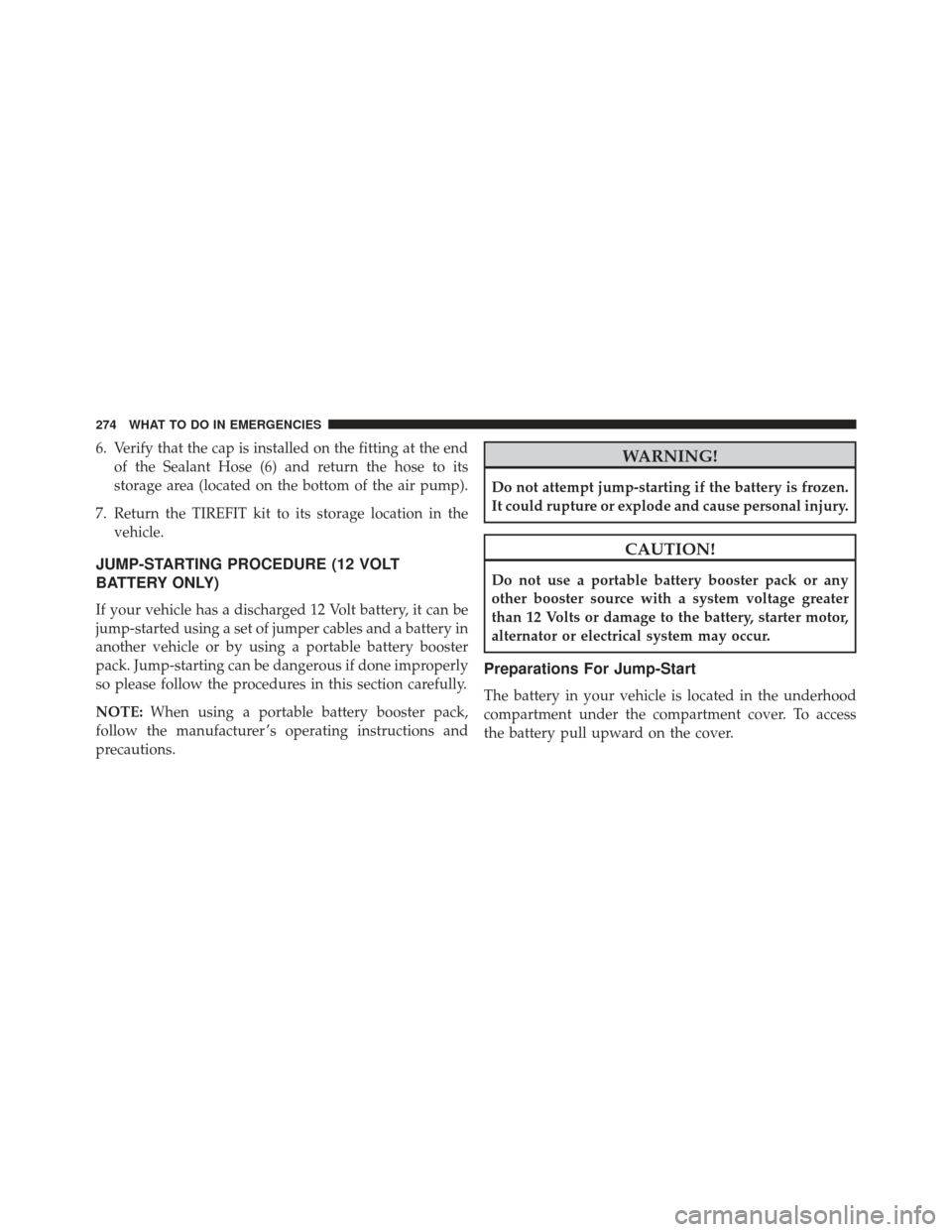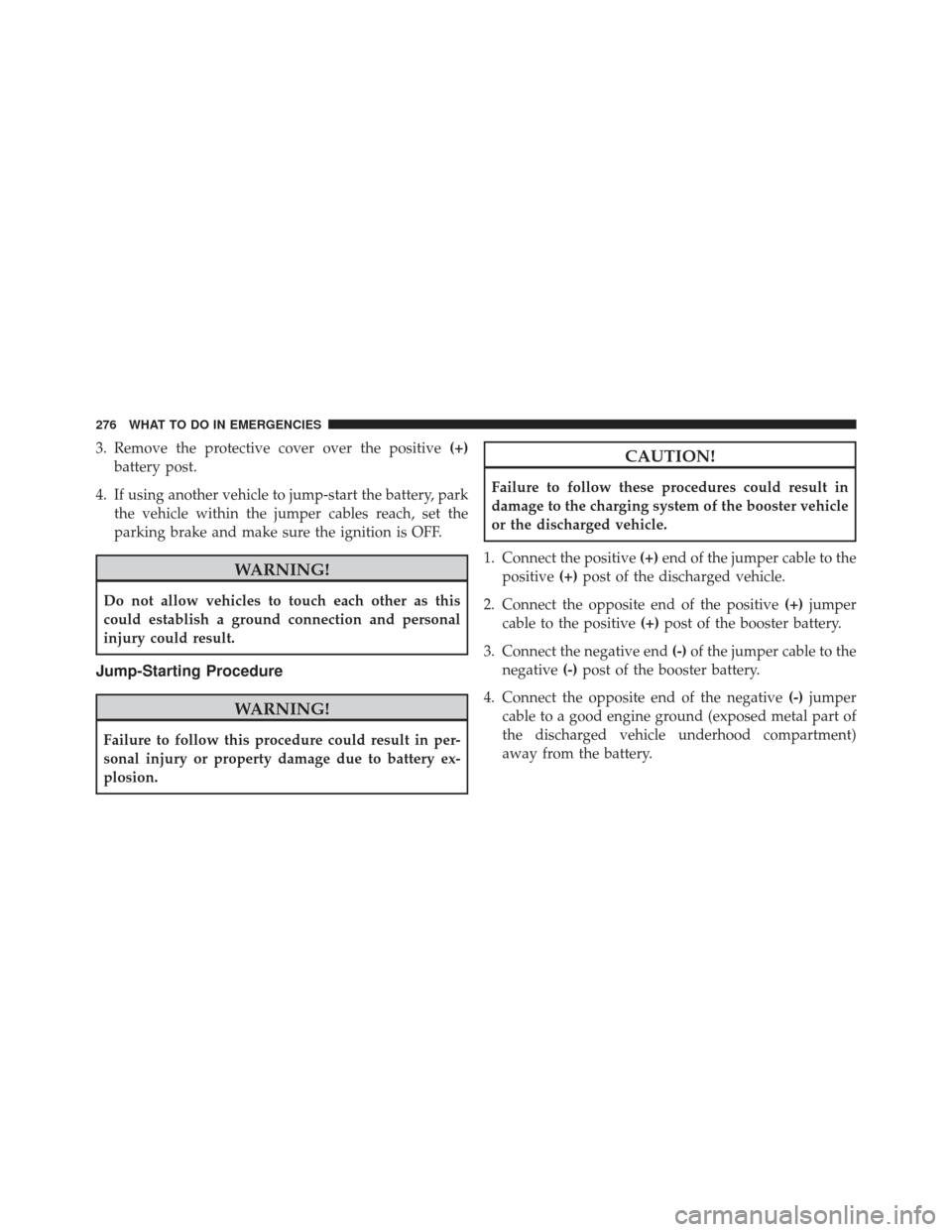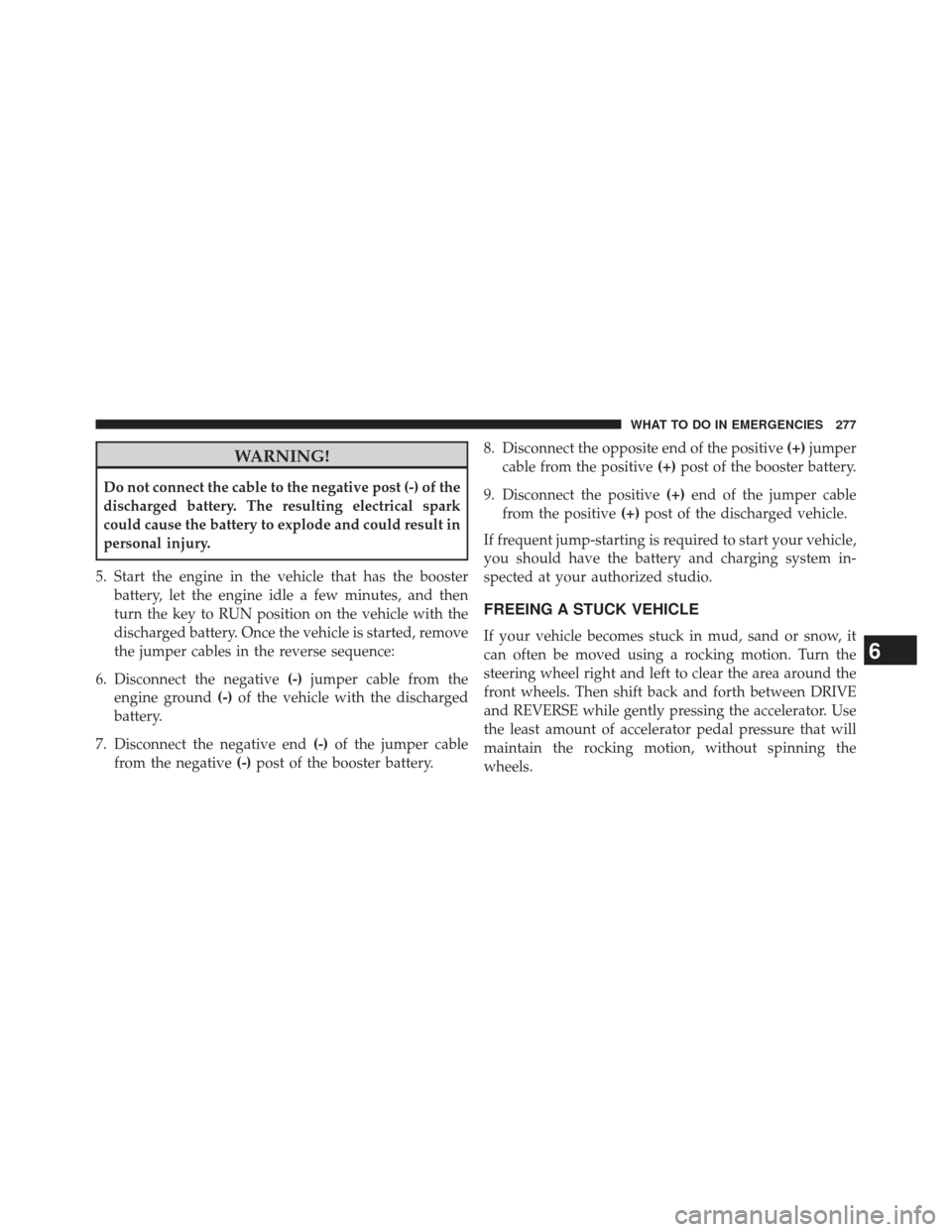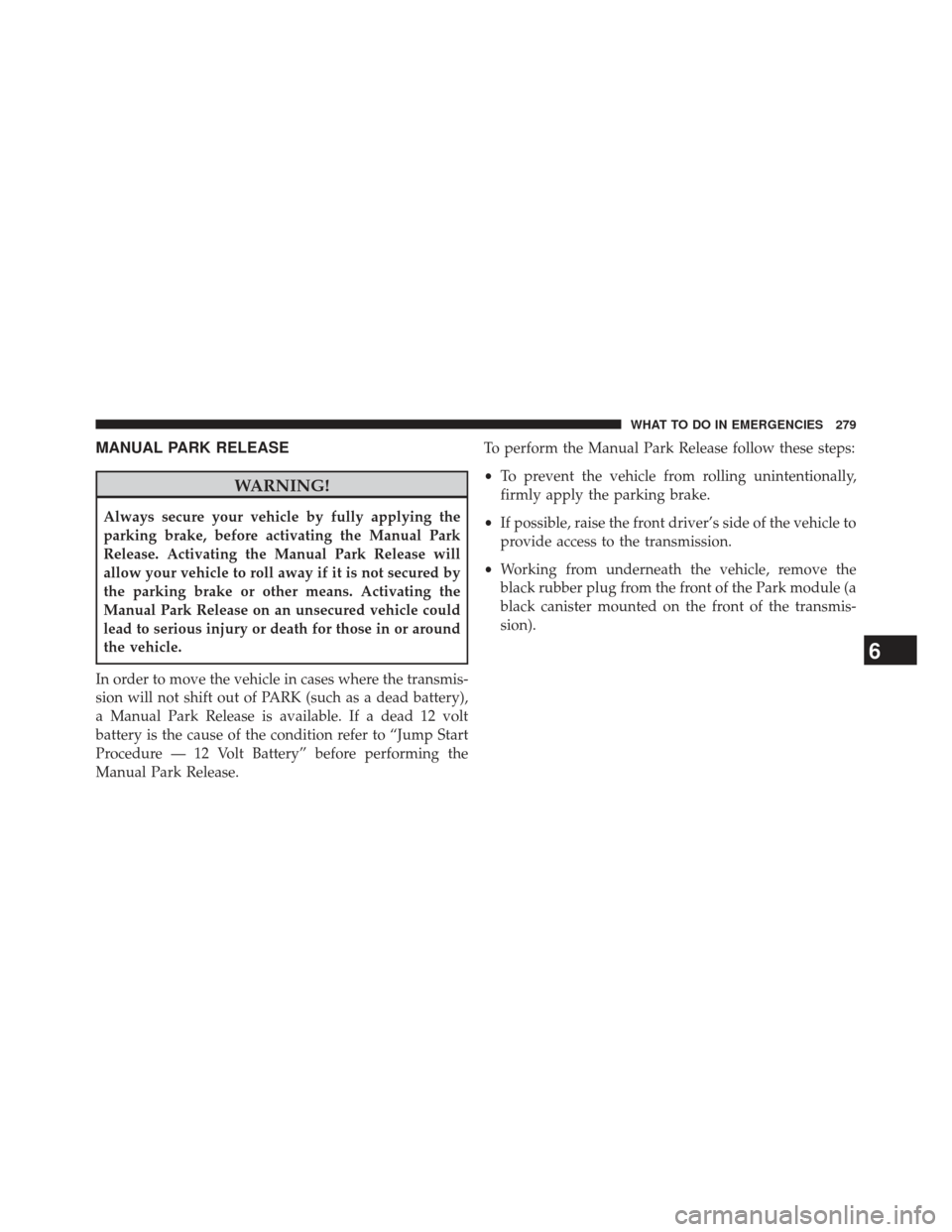Page 276 of 350

6. Verify that the cap is installed on the fitting at the endof the Sealant Hose (6) and return the hose to its
storage area (located on the bottom of the air pump).
7. Return the TIREFIT kit to its storage location in the vehicle.
JUMP-STARTING PROCEDURE (12 VOLT
BATTERY ONLY)
If your vehicle has a discharged 12 Volt battery, it can be
jump-started using a set of jumper cables and a battery in
another vehicle or by using a portable battery booster
pack. Jump-starting can be dangerous if done improperly
so please follow the procedures in this section carefully.
NOTE: When using a portable battery booster pack,
follow the manufacturer ’s operating instructions and
precautions.
WARNING!
Do not attempt jump-starting if the battery is frozen.
It could rupture or explode and cause personal injury.
CAUTION!
Do not use a portable battery booster pack or any
other booster source with a system voltage greater
than 12 Volts or damage to the battery, starter motor,
alternator or electrical system may occur.
Preparations For Jump-Start
The battery in your vehicle is located in the underhood
compartment under the compartment cover. To access
the battery pull upward on the cover.
274 WHAT TO DO IN EMERGENCIES
Page 277 of 350
WARNING!
•Take care to avoid the radiator cooling fan when-
ever the hood is raised. It can start anytime the
ignition switch is ON. You can be injured by
moving fan blades.
• Remove any metal jewelry such as rings, watch
bands and bracelets that could make an inadvertent
electrical contact. You could be seriously injured.
• Batteries contain sulfuric acid that can burn your
skin or eyes and generate hydrogen gas which is
flammable and explosive. Keep open flames or
sparks away from the battery.
1. Set the parking brake, place the transmission into PARK and turn the ignition to LOCK.
2. Turn off the heater, radio, and all unnecessary electri- cal accessories.
Battery Posts
1 — Positive (+) Post (Covered With Protective Cap)
2 — Negative (-) Post
6
WHAT TO DO IN EMERGENCIES 275
Page 278 of 350

3. Remove the protective cover over the positive(+)
battery post.
4. If using another vehicle to jump-start the battery, park the vehicle within the jumper cables reach, set the
parking brake and make sure the ignition is OFF.
WARNING!
Do not allow vehicles to touch each other as this
could establish a ground connection and personal
injury could result.
Jump-Starting Procedure
WARNING!
Failure to follow this procedure could result in per-
sonal injury or property damage due to battery ex-
plosion.
CAUTION!
Failure to follow these procedures could result in
damage to the charging system of the booster vehicle
or the discharged vehicle.
1. Connect the positive (+)end of the jumper cable to the
positive (+)post of the discharged vehicle.
2. Connect the opposite end of the positive (+)jumper
cable to the positive (+)post of the booster battery.
3. Connect the negative end (-)of the jumper cable to the
negative (-)post of the booster battery.
4. Connect the opposite end of the negative (-)jumper
cable to a good engine ground (exposed metal part of
the discharged vehicle underhood compartment)
away from the battery.
276 WHAT TO DO IN EMERGENCIES
Page 279 of 350

WARNING!
Do not connect the cable to the negative post (-) of the
discharged battery. The resulting electrical spark
could cause the battery to explode and could result in
personal injury.
5. Start the engine in the vehicle that has the booster battery, let the engine idle a few minutes, and then
turn the key to RUN position on the vehicle with the
discharged battery. Once the vehicle is started, remove
the jumper cables in the reverse sequence:
6. Disconnect the negative (-)jumper cable from the
engine ground (-)of the vehicle with the discharged
battery.
7. Disconnect the negative end (-)of the jumper cable
from the negative (-)post of the booster battery. 8. Disconnect the opposite end of the positive
(+)jumper
cable from the positive (+)post of the booster battery.
9. Disconnect the positive (+)end of the jumper cable
from the positive (+)post of the discharged vehicle.
If frequent jump-starting is required to start your vehicle,
you should have the battery and charging system in-
spected at your authorized studio.
FREEING A STUCK VEHICLE
If your vehicle becomes stuck in mud, sand or snow, it
can often be moved using a rocking motion. Turn the
steering wheel right and left to clear the area around the
front wheels. Then shift back and forth between DRIVE
and REVERSE while gently pressing the accelerator. Use
the least amount of accelerator pedal pressure that will
maintain the rocking motion, without spinning the
wheels.
6
WHAT TO DO IN EMERGENCIES 277
Page 281 of 350

MANUAL PARK RELEASE
WARNING!
Always secure your vehicle by fully applying the
parking brake, before activating the Manual Park
Release. Activating the Manual Park Release will
allow your vehicle to roll away if it is not secured by
the parking brake or other means. Activating the
Manual Park Release on an unsecured vehicle could
lead to serious injury or death for those in or around
the vehicle.
In order to move the vehicle in cases where the transmis-
sion will not shift out of PARK (such as a dead battery),
a Manual Park Release is available. If a dead 12 volt
battery is the cause of the condition refer to “Jump Start
Procedure — 12 Volt Battery” before performing the
Manual Park Release. To perform the Manual Park Release follow these steps:
•
To prevent the vehicle from rolling unintentionally,
firmly apply the parking brake.
• If possible, raise the front driver’s side of the vehicle to
provide access to the transmission.
• Working from underneath the vehicle, remove the
black rubber plug from the front of the Park module (a
black canister mounted on the front of the transmis-
sion).
6
WHAT TO DO IN EMERGENCIES 279
Page 283 of 350
Towing ConditionWheels OFF The Ground SINGLE-SPEED TRANSMISSION
Flat Tow NONENOT ALLOWED
Wheel Lift RearNOT ALLOWED
Front OK
Flatbed ALLOK
This vehicle must be towed on a flatbed truck or vehicle
trailer, with the front wheels OFF the ground.
If you must use the accessories (wipers, defrosters, etc.)
while being towed, the ignition must be in the ON/RUN
position, not the ACC position.
If the ignition key is unavailable, or the battery is
discharged, see “Manual Park Release” in “What To Do
In Emergencies” for instructions on shifting the transmis-
sion out of PARK for towing.
CAUTION!
DO NOT use sling-type equipment when towing.
When securing the vehicle to a flatbed truck, do not
attach to front or rear suspension components. Dam-
age to your vehicle may result from improper towing.
6
WHAT TO DO IN EMERGENCIES 281
Page 285 of 350

MAINTAINING YOUR VEHICLE
CONTENTS
�UNDERHOOD COMPARTMENT ...........285
� REPLACEMENT PARTS ..................286
� STUDIO SERVICE ..................... .286
� MAINTENANCE PROCEDURES ............287
▫ Power Electronics And Battery Thermal
Management Systems ...................288
▫ Power Electronics and Battery Thermal
Management Systems — Coolant Level
Check ............................. .288
▫ Power Electronics and Battery Thermal
Management Systems — Cooling Pressure
Caps .............................. .290▫
Selection Of Coolant ...................291
▫ Adding Coolant ...................... .292
▫ Power Electronics and Battery Thermal
Management Systems — Drain, Flush And
Refill ............................. .293
▫ Disposal Of Used Power Electronics and
Battery Thermal Management Systems
Coolant ............................ .294
▫ Points To Remember ...................294
▫ Maintenance-Free Battery 12 Volt ..........295
▫ Air Conditioner Maintenance .............296
▫ Body Lubrication .....................297
7
Page 287 of 350
UNDERHOOD COMPARTMENT
1 — Battery Thermal Coolant Reservoir2 — Power Electronics Coolant Reservoir
4 — Fuses 3 — Brake Fluid Reservoir
5 — Washer Fluid Reservoir
7
MAINTAINING YOUR VEHICLE 285